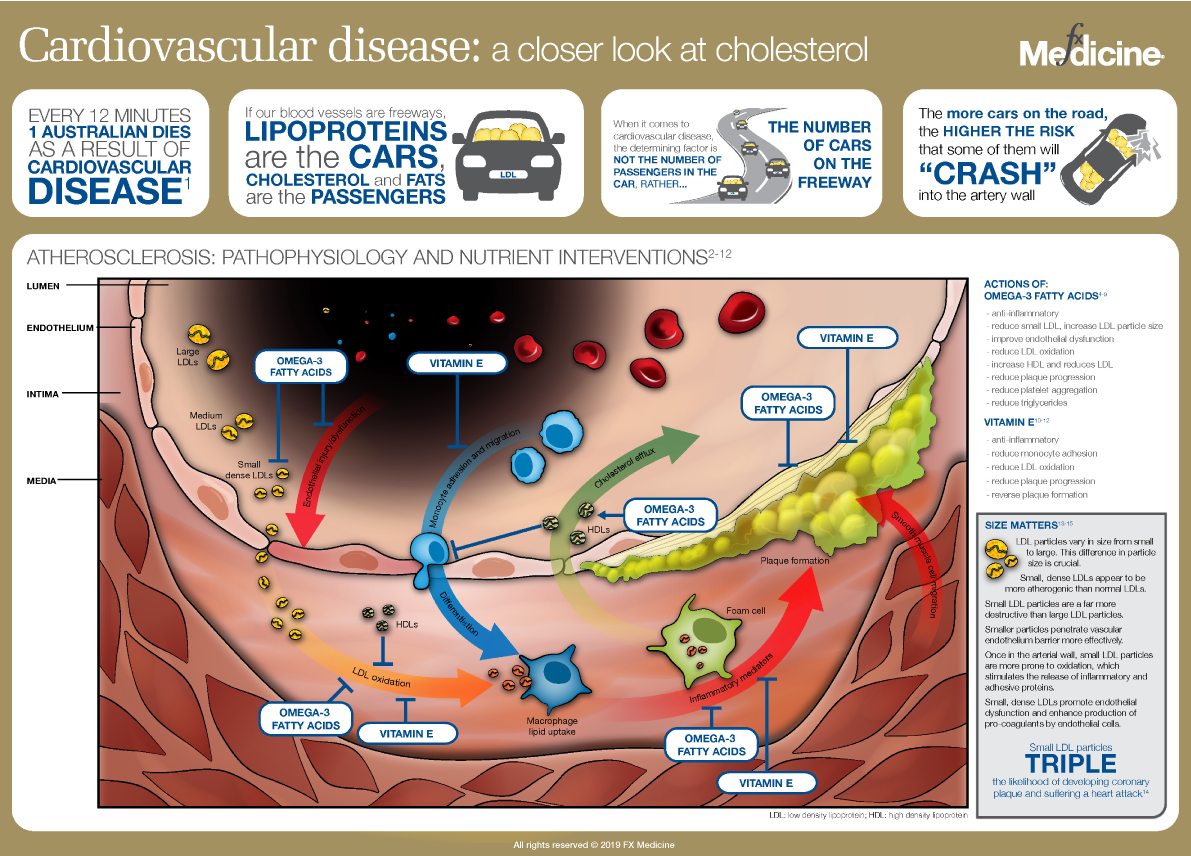
Every 12 minutes one Australian dies as a result of cardiovascular disease (CVD). Practitioners, and the general public, must develop a better understanding of what science is now revealing as key aetiologies for the development of this illness. This is not just a disease of high cholesterol and elevated blood pressure (BP). Atherosclerosis progression is now recognised to be influenced by factors including (but not limited to) nutritional deficiencies, systemic inflammation, oxidative stress, a dysbiotic gut, immune dysfunction (including autoimmune-type processes) and infections, together with the well known dietary and lifestyle issues.
A more advanced lipid profile may be an ideal approach to better determine the targets for disease treatment/prevention. Further to the standard measurements of triglycerides (TGs), high density lipoproteins (HDLs), low density lipoproteins (LDLs) and total cholesterol, other markers such as lipoprotein sub-fractions, apolipoproteins (Apo), C-reactive protein (CRP), fibrinogen, homocysteine and glycosylated haemoglobin (HbA1c) can be investigated. Complementary interventions which are proving successful in managing certain aspects of CVD include CoQ10/ubiquinol, fish oil, tocotrienols and tocopherols, resveratrol, curcumin and quercetin.
In this infographic we take a closer look at cholesterol and lipoprotein sub-fractions and research which supports the use of omega-3 fatty acids and vitamin E (mixed tocopherols and tocotrienols) in cardiovascular disease management.
References
- Australian Bureau of Statistics. Causes of death 2013 (3303.0). [Full text]
- Ferrari R, Hearse DJ. New approaches in atherothrombosis. Dialogues in Cardiovascular Medicine 2007;12(4):233-308. [PDF]
- Farid AS, Horii Y. Modulation of paraoxonases during infectious diseases and its potential impact on atherosclerosis. Lipids in Health and Disease 2012;11;92. DOI: 10.1186/1476-511X-11-92. [Full text]
- Nestel PJ. Fish oil and cardiovascular disease: lipids and arterial function. Am J Clin Nutr 2000;71(1):228S-231S. [Full text]
- Miyoshi T, Noda Y, Ohno Y, et al. Omega-3 fatty acids improve postprandial lipemia and associated endothelial dysfunction in healthy individuals - a randomized cross-over trial. Biomed Pharmacother 2014;68(8):1071-1077. [Abstract]
- Bays HE, Ballantyne CM, Braeckman RA, et al. Icosapent ethyl, a pure ester of eicosapentaenoic acid: Effects on circulating markers of inflammation from the MARINE and ANCHOR studies. Am J Cardiovasc Drugs 2013;13:37-46. [PDF]
- Kar S. Omacor and omega-3 fatty acids for treatment of coronary artery disease and the pleiotropic effects. Am J Ther. 2014;21(1):56-66. [Abstract]
- Skulas-Ray AC, Alaupovic P, Kris-Etherton PM, et al. Dose-response effects of marine omega-3 fatty acids on apolipoproteins, apolipoprotein-defined lipoprotein subclasses, and Lp-PLA2 in individuals with moderate hypertriglyceridemia. J Clin Lipidol 2015;9(3):360-367. [Abstract]
- Kasbi Chadli F, Nazih H, Krempf M, et al. Omega 3 fatty acids promote macrophage reverse cholesterol transport in hamster fed high fat diet. PLoS One 2013;8(4):e61109. [Full text]
- Naito Y, Shimozawab M, Kurodab M, et al. Tocotrienols reduce 25-hydroxycholesterol-induced monocyte–endothelial cell interaction by inhibiting the surface expression of adhesion molecules. Atherosclerosis 2005;180(1):19-25. [Abstract]
- Tomeo AC, Geller M, Watkins TR, et al. Antioxidant effects of tocotrienols in patients with hyperlipidemia and carotid stenosis. Lipids 1995;30(12):1179-1183. [Abstract]
- Li F, Tan W, Kang Z, et al. Tocotrienol enriched palm oil prevents atherosclerosis through modulating the activities of peroxisome proliferators-activated receptors. Atherosclerosis 2010b;211: 278–282. [Abstract]
- St-Pierre AC, Ruel IL, Cantin B, et al. Comparison of various electrophoretic characteristics of LDL particles and their relationship to the risk of ischemic heart disease. Circulation 2001;104(19):2295-2299. [Full text]
- Kwiterovich PO, Jr. Clinical relevance of the biochemical, metabolic, and genetic factors that influence low-density lipoprotein heterogeneity. Am J Cardiol 2002;90(8A):30i-47i. [Abstract]
- Lamarche B, Tchernof A, Moorjani S, et al. Small, dense low-density lipoprotein particles as a predictor of the risk of ischemic heart disease in men. Prospective results from the Quebec Cardiovascular Study. Circulation 1997;95(1):69-75. [Full text]
This image by FX Medicine is licensed under a Creative Commons Attribution-NonCommercial-NoDerivatives 4.0 International License.
More information about how to share/use the infographics for personal use.
If you interested in using any FX Medicine content for commercial use please contact us.
DISCLAIMER:
The information provided on FX Medicine is for educational and informational purposes only. The information provided on this site is not, nor is it intended to be, a substitute for professional advice or care. Please seek the advice of a qualified health care professional in the event something you have read here raises questions or concerns regarding your health.




